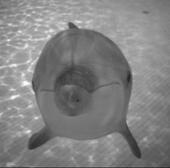
The Sonar System
The bottlenose dolphin has an advanced sonar system. Sound is generated in the nasal cavity area just below the blowhole. A large fat body called the melon directs the sound into a narrow beam (-3 dB beam width) with a beam axis 5º to 10º above the longitudinal axis of the skull. Sound is received through the acoustic window, which is a thin walled area on the lower jaw. From here the sound is transported and amplified through a fat-filled channel into the auditory bulla, which contains the middle and inner ear.
When emitted sound hits a target the majority of the sound waves reflect on the front surface of the object creating an echo highlight. A large part of the sound waves however; passes through the front surface, scatters in the interior structures of the object, and reflects back through other paths with a delay. Circumferential waves travel around the object. Hence, a target object with complex shape and surface structures will reflect back an echo with many highlights. Highlights are more distinct and easier separated if sound emissions are short and sharp. A dolphin can determine distance, location, size, shape and interior properties of an object by scanning across the object or by “illuminating” it with short pulses (clicks) from different angles. They can detect an object over a 100 m distance. These clicks are usually emitted in trains were the inter-click-intervals (I-C-I) are a little longer than the two-way travel time to the target object. The approximate distance from which a dolphin emits sound can be calculated by the I-C-I of recorded sonar sound.
Responsible for this page:
Director of undergraduate studies Biology
Last updated:
06/10/05
